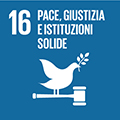- Docente: Giulia Fabini
- Crediti formativi: 8
- SSD: SPS/04
- Lingua di insegnamento: Inglese
- Modalità didattica: Convenzionale - Lezioni in presenza
- Campus: Bologna
- Corso: Laurea Magistrale in International Relations (cod. 9084)
-
dal 16/09/2024 al 09/12/2024
Conoscenze e abilità da conseguire
Objectives: The course is designed to give students a general overview and understanding of the international and European criminological debate concerning border control and a detailed knowledge of key topics and key scholars in the field. Students are expected to be able to combine their knowledge of different contexts and disciplinary approaches when analysing border policies. The goal of the course is that students acquire the competences and knowledge necessary to analyze critically the contemporary policies of border control in different contexts, also in view of possible fields of work and research: border police, the role and functioning of administrative detention and deportation, the international relations of the externalization of borders, the use of criminal law in border control.
Contenuti
As for exchange students: the course is open exclusively to students (Erasmus, Turing, Overseas, …) enrolled in Master’s level degrees.
The course is organised into lectures and seminars, as detailed in the following program and further developed in the syllabus uploaded in VIRTUALE before the beginning of the course. The course will present the contemporary debate in the field known as "border criminology". This is a recently emerged field of criminological research, which merges insights from border studies, critical migration studies, and the criminological interest over border control. The label of "border criminology" identifies an interdisciplinary body of criminological literature concerned with borders and, more specifically, concerned with how border control in times of globalization is bringing about important changes in the field of Criminal justice, punishment, sovereignty and membership in continuously changing and increasingly complex societies.
At the end of the course, students will be expected to be able to analyse the mechanisms of power subtending the processes of illegalization, detention, deportation, refusal and criminalization of migrants. The perspective developed in the course embraces a critical approach and considers law, policies, and discourses as entrenched factors in driving the mechanisms of border control. The focus of the analysis will be the European context, analysed through comparative perspective as much as possible. Special attention will be given to the intersection of race, class and gender in the law-making and law-enforcement activities. Not only the securitization of border will be taken into account, but also the more recently emerged “humanitarian control” will be considered as an object of possible criminological enquiry.
The course is organized in lectures and seminars. Students are required to carefully read the assigned material before each class and are expected to actively participate in class discussion.
Lectures will first introduce the students to the critical perspective in criminology and to the main topics and the theoretical debate of border criminology. It then will provide an introduction to the theoretical key concepts in border criminology, and especially the question of punishment, the nature of borders, and the transnational perspective we aim to adopt in the course, with an attention to the possibility of transforming borders from below. Then, the lectures will investigate the different countries in Europe where one can observe the mechanisms of border control, highlighting the variety of cases. Each of them will be discussed through empirical and theoretical researches carried out in different contexts.
Lectures
- Introduction to critical criminology and border criminology
- The illegalization processes and deportability
- The perspective of border performativity: multi-scalar and transnational governance of migration
- Class discussion
- Crimmigration debate in the US and in the EU and its critiques
- Pre-removal detention: theories, numbers, functions
- Border policing: discretion, internal borders and the instrumental use of immigration law
- Deportation
- Using quantitative data on migration enforcement to do research
- Securitarian-Humanitarian control and the criminalization of refugees and asylum seekers
- Temporal borders and life in camps in Greece
- Push-backs and violence at the borders in the Balkans
- Pre-removal immigration detention in Italy
- The deportation machine in Spain
- Digital borders
- Gender perspective on migration control: Sexual trafficking, sex worker and the ideal victim
- The ordered and the bordered society: the role of the state in border control
- The European Pact on Migration and asylum (part I)
- The European Pact on Migration and asylum (part II)
- Conclusions
Testi/Bibliografia
All students should read the following compulsory articles:
- Bosworth Mary, Franko Katja, Pickering Sharon (2018), “Punishment, globalization and migration control: ‘Get them the hell out of here’”, Punishment & Society 20(1): 34–53
- De Genova Nicholas (2002) Migrant “illegality” and deportability in everyday life. Annual Review of Anthropology (31): 419–447
- Fabini Giulia (2017) Managing illegality at the internal border: Governing through ‘differential inclusion’ in Italy. European Journal of criminology 14(1): 46-62.
- Stumpf, J.P. (2006) «The Crimmigration Crisis: Immigrants, Crime, and Sovereign power», in American University Law Review, 56, 367.
- Wonders Nancy (2006) Global flows, semi-permeable borders and new channels of inequality: Border crossers and border performativity. In: Pickering S and Weber L (eds) Borders, Mobility and Technologies of Control. Heidelberg: Springer, 63–86.
Students who regularly attend classes should read the following:
The above listed readings plus other readings, mainly articles and chapters of books, according to the topic discussed. The syllabus will be distributed before the beginning of the course and will be uploaded on the web page.
Students who do not regularly attend classes should also read the following texts:
- Aas Katja Franko and Bosworth Mary (2013) The borders of Punishment: Migration, Citizenship and the Northern Penal State. Oxford: Oxford University Press.
- Koulish, R., & van Der Woude, M. A. H. (Eds.). (2020). Crimmigrant Nations. Fordham University Press. (Introduction, chapters 1, 2, 3; plus one chapter according to the student) –
- Koulish et al. can be sostituted with a different book, mainly a monograph, in the field of border criminology. This should be agreed in advance with the lecturer, prior to the exam.
Metodi didattici
The course will use different teaching methods to provide students with knowledge on border criminology but also to help them develop critical thinking skills: lectures, seminars, class presentations, papers. The active participation of students during the course will be strongly encouraged.
Modalità di verifica e valutazione dell'apprendimento
- Class presentation of one of the readings (30% of the final grade)
- 3000-words final essay (70% of the final grade)
Students who do not regularly attend classes will be assessed through a final oral exam
Strumenti a supporto della didattica
Power-point, visual material, collective discussions.
Orario di ricevimento
Consulta il sito web di Giulia Fabini
SDGs




L'insegnamento contribuisce al perseguimento degli Obiettivi di Sviluppo Sostenibile dell'Agenda 2030 dell'ONU.
